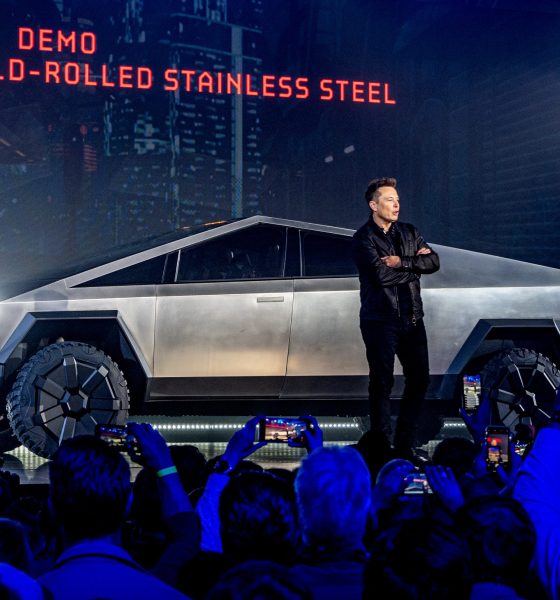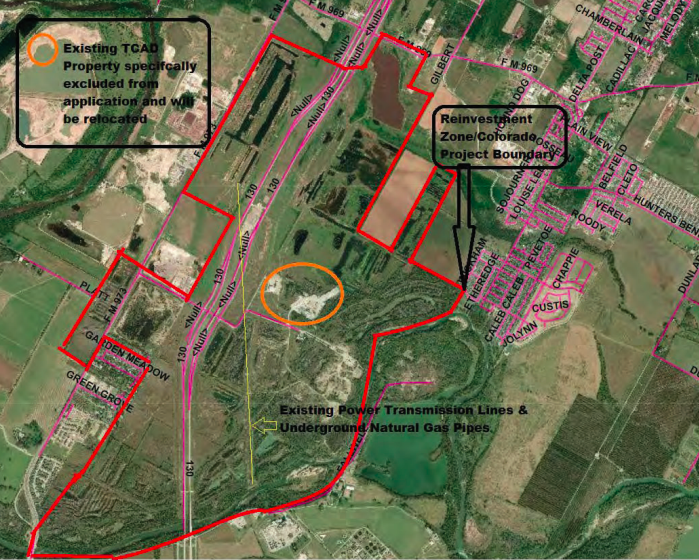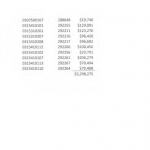

News
Tesla offered Texas land for Cybertruck factory [Updated]
Update: Elon Musk has clarified that Tesla currently has the option to purchase the Austin, TX land. But so far, Musk has stated that the electric car maker has not exercised it.
Tesla has an option to purchase this land, but has not exercised it
— Elon Musk (@elonmusk) June 18, 2020
— Original article follows —
Tesla has acquired a 2,100-acre plot of land 12 miles outside of Austin in what could be the home to its upcoming Cybertruck production facility.
An application from the Texas Comptroller’s office describes Tesla’s plans to develop and design a “high-tech electric vehicle manufacturing plant in Travis County.” This provides a strong indicator that Tesla has chosen Texas to be the home of its next EV production facility.
The application states, “Tesla Inc is evaluating the possible development, design, and construction of a high tech electric vehicle manufacturing plant in Travis County within the Austin Green property located at the intersection of SH-130 and Harold Green Road. Attached is an exhibit that shows the planned layout of the facility on the site and is subject to confidentiality assertions above.”
The red outlined area is the plot of land that Tesla has reportedly purchased.

According to documents, the plant will “ultimately comprise a 4-5 million square foot manufacturing plant. Construction timing is still to be determined but anticipated to be sometime over the next 2-3 years pending required approvals.”
Tesla purchased the land for $5,298,275, documents from the State of Texas indicate. The document also indicates that construction will begin in the third quarter of 2020, pending required approval from the State of Texas.
All indications until this point has led to Tesla utilizing the Lone Star State for its next, and possibly largest, production facility to date. In January, CEO Elon Musk tested the waters to see if Texas was the appropriate location for its next factory via a Twitter poll. The results were overwhelmingly positive, with 80% of the 305,724 participants in the survey being in favor of a “Giga Texas.”
- Credit: State of Texas/Travis County
- Credit: State of Texas/Travis County
The production facility will be Tesla’s fifth production facility behind Gigafactory Nevada, Gigafactory New York, Gigafactory Shanghai, and Gigafactory Berlin. It will be the fourth electric vehicle production facility behind the Fremont factory, Shanghai, and Berlin.
The facility will likely produce the Tesla Cybertruck, along with the Model Y crossover. The production of the Cybertruck’s Dual and Tri-Motor variants is expected to begin in late 2021.
With the Cybertruck’s production date scheduled for late next year, Giga Texas could operate much like Giga Shanghai, which started vehicle production activities as soon as the first phase of the plant was completed. In Shanghai, Tesla is completing the 2nd Phase of the facility, which will build the Model Y crossover. This strategy will likely be implemented in Texas to keep Cybertruck production on schedule as much as possible.
Musk’s indication of Texas being Tesla’s new home has finally come to fruition. After hinting for months that Texas would ultimately be the location of the electric automaker’s new facility for months, documents indicate that Tesla will begin construction in the third quarter of 2020, and could be cranking out electric vehicles as soon as 2021.

Elon Musk
Elon Musk and Tesla AI Director share insights after empty driver seat Robotaxi rides
The executives’ unoccupied tests hint at the rapid progress of Tesla’s unsupervised Robotaxi efforts.

Tesla CEO Elon Musk and AI Director Ashok Elluswamy celebrated Christmas Eve by sharing personal experiences with Robotaxi vehicles that had no safety monitor or occupant in the driver’s seat. Musk described the system’s “perfect driving” around Austin, while Elluswamy posted video from the back seat, calling it “an amazing experience.”
The executives’ unoccupied tests hint at the rapid progress of Tesla’s unsupervised Robotaxi efforts.
Elon and Ashok’s firsthand Robotaxi insights
Prior to Musk and the Tesla AI Director’s posts, sightings of unmanned Teslas navigating public roads were widely shared on social media. One such vehicle was spotted in Austin, Texas, which Elon Musk acknowleged by stating that “Testing is underway with no occupants in the car.”
Based on his Christmas Eve post, Musk seemed to have tested an unmanned Tesla himself. “A Tesla with no safety monitor in the car and me sitting in the passenger seat took me all around Austin on Sunday with perfect driving,” Musk wrote in his post.
Elluswamy responded with a 2-minute video showing himself in the rear of an unmanned Tesla. The video featured the vehicle’s empty front seats, as well as its smooth handling through real-world traffic. He captioned his video with the words, “It’s an amazing experience!”
Towards Unsupervised operations
During an xAI Hackathon earlier this month, Elon Musk mentioned that Tesla owed be removing Safety Monitors from its Robotaxis in Austin in just three weeks. “Unsupervised is pretty much solved at this point. So there will be Tesla Robotaxis operating in Austin with no one in them. Not even anyone in the passenger seat in about three weeks,” he said. Musk echoed similar estimates at the 2025 Annual Shareholder Meeting and the Q3 2025 earnings call.
Considering the insights that were posted Musk and Elluswamy, it does appear that Tesla is working hard towards operating its Robotaxis with no safety monitors. This is quite impressive considering that the service was launched just earlier this year.
Elon Musk
Starlink passes 9 million active customers just weeks after hitting 8 million
The milestone highlights the accelerating growth of Starlink, which has now been adding over 20,000 new users per day.

SpaceX’s Starlink satellite internet service has continued its rapid global expansion, surpassing 9 million active customers just weeks after crossing the 8 million mark.
The milestone highlights the accelerating growth of Starlink, which has now been adding over 20,000 new users per day.
9 million customers
In a post on X, SpaceX stated that Starlink now serves over 9 million active users across 155 countries, territories, and markets. The company reached 8 million customers in early November, meaning it added roughly 1 million subscribers in under seven weeks, or about 21,275 new users on average per day.
“Starlink is connecting more than 9M active customers with high-speed internet across 155 countries, territories, and many other markets,” Starlink wrote in a post on its official X account. SpaceX President Gwynne Shotwell also celebrated the milestone on X. “A huge thank you to all of our customers and congrats to the Starlink team for such an incredible product,” she wrote.
That growth rate reflects both rising demand for broadband in underserved regions and Starlink’s expanding satellite constellation, which now includes more than 9,000 low-Earth-orbit satellites designed to deliver high-speed, low-latency internet worldwide.
Starlink’s momentum
Starlink’s momentum has been building up. SpaceX reported 4.6 million Starlink customers in December 2024, followed by 7 million by August 2025, and 8 million customers in November. Independent data also suggests Starlink usage is rising sharply, with Cloudflare reporting that global web traffic from Starlink users more than doubled in 2025, as noted in an Insider report.
Starlink’s momentum is increasingly tied to SpaceX’s broader financial outlook. Elon Musk has said the satellite network is “by far” the company’s largest revenue driver, and reports suggest SpaceX may be positioning itself for an initial public offering as soon as next year, with valuations estimated as high as $1.5 trillion. Musk has also suggested in the past that Starlink could have its own IPO in the future.
News
NVIDIA Director of Robotics: Tesla FSD v14 is the first AI to pass the “Physical Turing Test”
After testing FSD v14, Fan stated that his experience with FSD felt magical at first, but it soon started to feel like a routine.

NVIDIA Director of Robotics Jim Fan has praised Tesla’s Full Self-Driving (Supervised) v14 as the first AI to pass what he described as a “Physical Turing Test.”
After testing FSD v14, Fan stated that his experience with FSD felt magical at first, but it soon started to feel like a routine. And just like smartphones today, removing it now would “actively hurt.”
Jim Fan’s hands-on FSD v14 impressions
Fan, a leading researcher in embodied AI who is currently solving Physical AI at NVIDIA and spearheading the company’s Project GR00T initiative, noted that he actually was late to the Tesla game. He was, however, one of the first to try out FSD v14.
“I was very late to own a Tesla but among the earliest to try out FSD v14. It’s perhaps the first time I experience an AI that passes the Physical Turing Test: after a long day at work, you press a button, lay back, and couldn’t tell if a neural net or a human drove you home,” Fan wrote in a post on X.
Fan added: “Despite knowing exactly how robot learning works, I still find it magical watching the steering wheel turn by itself. First it feels surreal, next it becomes routine. Then, like the smartphone, taking it away actively hurts. This is how humanity gets rewired and glued to god-like technologies.”
The Physical Turing Test
The original Turing Test was conceived by Alan Turing in 1950, and it was aimed at determining if a machine could exhibit behavior that is equivalent to or indistinguishable from a human. By focusing on text-based conversations, the original Turing Test set a high bar for natural language processing and machine learning.
This test has been passed by today’s large language models. However, the capability to converse in a humanlike manner is a completely different challenge from performing real-world problem-solving or physical interactions. Thus, Fan introduced the Physical Turing Test, which challenges AI systems to demonstrate intelligence through physical actions.
Based on Fan’s comments, Tesla has demonstrated these intelligent physical actions with FSD v14. Elon Musk agreed with the NVIDIA executive, stating in a post on X that with FSD v14, “you can sense the sentience maturing.” Musk also praised Tesla AI, calling it the best “real-world AI” today.










